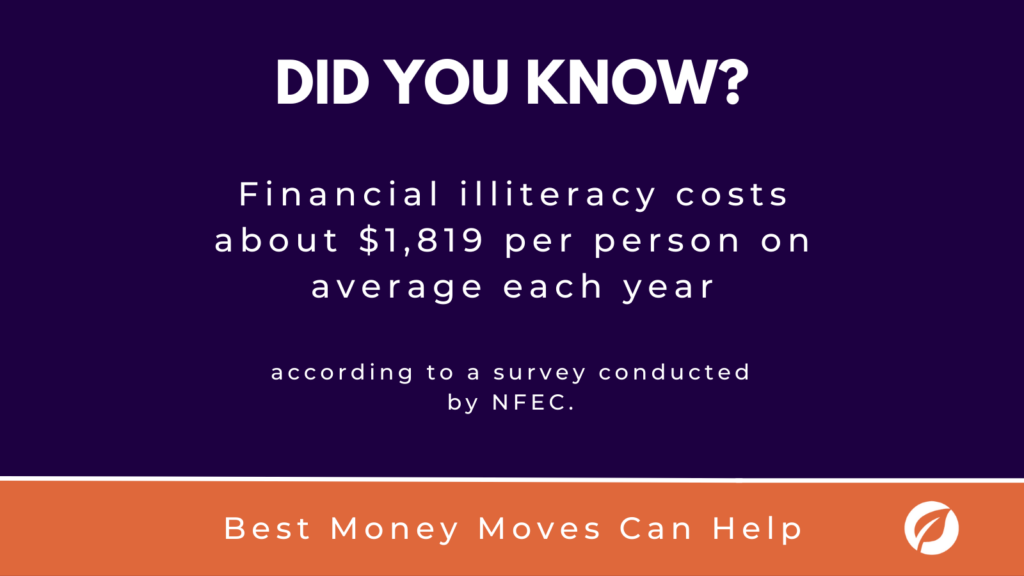How much does financial literacy cost your team? Financial illiteracy is a growing problem among American workers. Here’s how financial wellness can help your team thrive.
Financial illiteracy is a growing problem among Americans and it could be costing your people dearly. An NFEC survey found that financial illiteracy costs about $1,819 per person on average. In fact, 15% of those surveyed said their lack of knowledge cost them upwards of $10,000. Luckily, the right financial wellness program can help your team.
What is financial illiteracy?
Financial illiteracy refers to a person’s lack of understanding about personal finance and related concepts. Financial illiteracy comes in many forms including:
- Misunderstanding basic financial concepts such as interest or inflation
- Being unable to save money, create an emergency fund or build a budget
- Misusing credit cards and struggling to pay off debt
- Taking out high interest loans with no repayment plan
- Missing out on long-term investment/retirement opportunities
A lack of financial literacy can prevent someone from managing their day-to-day financial affairs and slow a person’s ability to long-term goals. According to a Banrakate study, 56% of Americans are unable to cover $1,000 for an emergency fund, making it difficult to plan for the future. People who are financially illiterate may also be unaware of the consequences of poor financial decisions, potentially leaving them trapped in cycles of bad debt.
Annually, the biggest culprit of money lost to financial illiteracy is credit card interest and late fees, totalling around $120 billion among all Americans, according to the same NFCC survey. The next highest offenders are luxury spending at $64.8 billion and overdrafts at $17 billion. Other common financial drains included identity theft and fraud, which cost Americans around $13 billion collectively.
Many of these costs would be otherwise avoidable, if employees had access to more comprehensive financial education.
How can financial illiteracy impact a workforce?
Financial illiteracy can lead to stress, poor decision making and decreased productivity while at work, among other things. Even the highest earners aren’t safe from the dangers of financial illiteracy. A 2022 survey conducted by Willis Towers Watson found that 36% of Americans making over $100,000 a year still lived paycheck to paycheck — an amount double that of 2019.
These financial issues may increase stress levels that can affect employees while on the job. A Morgan Stanley survey found that 78% of employees with high financial stress see its effects while at work. Another 49% claim that they spend 3 or more hours during their work week dealing with their financial issues. Beyond being a major distraction, this additional stress has many dangerous mental health implications for employees.
A 2019 survey found that employees with money worries were 4 times more likely to suffer
from depression and 3.4 times more likely to suffer from anxiety and panic attacks. Because of the major effects financial struggles have on employees, many employers have started to take notice. According to Forbes, 80% of employers in the U.S. report that financial stress is lowering their employees’ productivity. These companies also lose almost half a trillion dollars a year due to employees’ financial stress.
These issues have clear and measurable effects on workers, so solving them is in the best interest of every employer.
How can employers improve financial literacy?
Employees make some of their most important financial decisions in the workplace, whether they are beginning a retirement plan or choosing a health insurance provider. So, providing financial education at work can help combat the most common consequences of financial illiteracy.
Developing a strategy that teaches the basics of personal finance can be a great boon for your employees. Financial wellness programs can cover topics like budgeting, saving, investing and debt management.
The same Morgan Stanley survey found that around 74 percent of workers consider it important for their employer to provide financial wellness benefits, while 60 percent expressed their increased likelihood of staying at their current job if financial wellness benefits were offered. A 2020 survey from HR Daily Advisor found that 90% of employers who offered financial wellness benefits say that the programs had a positive impact on employees.
Financial literacy is an essential skill that employees need. The cost of financial illiteracy can be significant for them and for your own business. Help your employees improve their financial literacy with Best Money Moves.
Best Money Moves is a mobile-first financial wellness solution designed to help employees dial down their financial stress and meet their most top-of-mind financial goals. With budgeting tools and personalized money coaching, users can easily receive compressive financial advice right from their phones.
Best Money Moves is designed to guide employees through the most difficult financial times and topics. Our dedicated resources, partner offerings, and 700+ article library make Best Money Moves a leading benefit in bettering employee financial wellness.
To learn more about Best Money Moves Financial Wellness Platform, let’s schedule a call. Contact us and we’ll reach out to you soon.






